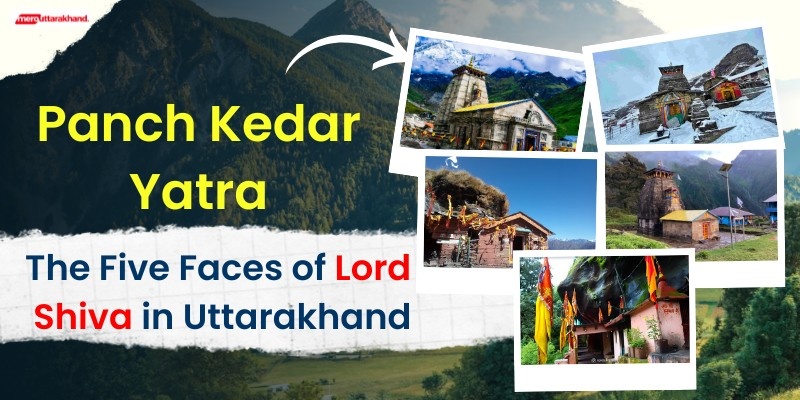Panch Kedar Yatra in Uttarakhand: History,Trek, Temples
Kajal, 2 days ago, 5 min read, 4 Views

Panch Kedar Introduction
Hidden away in Uttarakhand’s majestic Garhwal Himalayas are The Panch Kedar Temples – five temples that are highly revered for being dedicated to Lord Shiva. It is well known area visited by trek lovers and pilgrims as it includes Kedarnath Temple, Tungnath Temple, Rudranath Temple, Madhyamaheshwar Temple and Kalpeshwar Temple.
You can have an adventurous odyssey through the amazing landscapes in India, with a spiritual side added to it on every temple – each has its own tale – which is said to involve going there during the summer season while the best time for commencing holy journeys to these sacred spots is considered to be April or May.
History of Panch Kedar in Uttarakhand
The creation of the Panch Kedar temples is the subject of several myths. One of the best-known of these legends is that the Pandavas felt bad about killing their instructors and blood relatives during the Kurukshetra War. They went to Lord Krishna and requested from him a way to purge the sin. Since Lord Shiva is the only god who can atone for their sins, Lord Krishna gave them the order to see him. They proceeded to Kasi in pursuit of the lord, but after much slaughter during the conflict, he became enraged with them and fled Kashi, taking refuge at Guptkashi, which is now in Uttarakhand. But Pandavas extended their hand and followed him. He then travelled to a village called “Kedar,” which is tucked away in the Himalayan Mountains.
The Pandavas proceeded to Kedar village as well, driven by their strong desire to meet him. In order to blend in with the other animals grazing nearby, Lord Shiva assumed the form of a bull. He began to enter the soil, nevertheless, for Bhima (one of the Pandavas) had recognised him and grabbed him by his hump. The Pandavas had prayed to Lord Shiva and asked for his forgiveness. Then, in his true form, Lord Shiva emerged, gratified by their petition and their sense of remorse. Five locations in Uttarakhand now had the bull’s bodily parts visible. All five locations have temples built by the Pandavas. All together, these five locations are referred to as Panch Kedar.
Information about Panch Kedar in Uttarakhand
Below are five holy temples dedicated to the Lord Shiva known as Panch Kedar in the Garhwal region of Uttarakhand.
Kedarnath
The Kedar King was named Kedarnath’s great Hindu pilgrimage centre. The temple of Kedarnath is surrounded by deep forests and beautiful snow-capped mountains. Within it sits at 3,584 meters above sea level in Rudraprayag part of Uttarakhand state, this temple is among the five most famous Hindu temples of Panch Kedar reef. At the temple is a conical Shiva lingam called the hump of Shiva. The existing temple was built in the eighth or ninth century using slabs of grey stone, and it is credited to Adi Shankaracharya.
The closest driveable route to Kedarnath is the Gaurikund. After that, a 16-kilometer journey is needed to reach the temple. The Kedarnath Yatra is a strenuous walk, but the breathtaking environment it passes through keeps pilgrim’s spirits high all year round. As a result, thousands of people participate in the Kedarnath yatra each year. It is a common misconception that everybody who completes the Kedarnath Yatra and visits the sacred temple would be granted a spot in heaven. Kedarnath is a part of Char Dham in Uttarakhand.
Tungnath
Situated in the foothills of the Himalayas, at an elevation of 3680 meters above sea level, is the second of the Panch Kedar Uttarakhand circuit, Tungnath Temple. According to legend, it is the highest Shiva temple on the planet. It falls under the Rudraprayag district’s constituency in Uttarakhand. This is the location where people worship the forelegs of Lord Shiva, which have manifested as a bull. It is also thought that Lord Rama meditated here to atone for his transgression of “Brahma Hatya.” Tungnath Temple is well-known as a trekking destination in addition to being a place of pilgrimage.
Among the notable peaks that can be seen from this temple are Neelkanth, Kedarnath, Nanda Devi, and Choukhamba. The stunning trekking paths that lead to Tungnath Temple wind through a thick forest greeted with exquisite rhododendrons. The most well-known Chandrashila Peak, also known as Moon Rock, is situated one kilometer away and is well-known for its breathtaking 360-degree panorama of deep valleys and snow-capped mountains.
Rudranath
That is the location where the face of Shiva initial emerged from the ground. Situated among thick rhododendron trees and alpine meadows at a height of 2,286 meters, a natural rock temple honors Shiva as “Neelkanth Mahadev”. Numerous sacred kunds, or pools, surround the temple: Surya Kund, Chandra Kund, Tara Kund, and Mana Kund.
The beautiful peaks of Trishul, Nanda Devi, and Nanda Ghunti form a breathtaking backdrop. It’s believed that the journey there is more challenging than to other Panch Kedar temples. Most of the 20-kilometer treks to Rudranath start at Gopeshwar, at different points (in the Chamoli district).
Madhyamaheswar
At an estimated height of 3,289 meters, Madhyamaheswar is said to be the site of Shiva’s middle or navel section’s first manifestation. Situated in the Mansoona hamlet in the Garhwal Himalayas, the temple is flanked by the breathtaking snow-covered peaks of Chaukhamba, Neelkantha, and Kedarnath.
The location of the temple is in a wonderful green valley. The beginning of the walk to Madhyamaheswar lies in Uniana, which is roughly eighteen km from Ukhimath. It is possible to walk the entire 19 kilometers (approximately 10 km from Uniana) with ease until you reach Bantoli, after which the slope becomes more difficult and steep.
Kalpeshwar
According to legend, Lord Shiva’s hair, called jatas came out in the Kalpeshwar temple. Shiva is sometimes called Jatadhari or Jateshwar because of his jumbled up long hair. The Kalpeshwar temple is situated in the beautiful Urgam valley in Chamoli district of Uttarakhand where it rises to an altitude of 2,200 feet.
Although mostly buried in dense forest, the Urgam valley offers wonderful views of terraced fields with potato plantings and apple orchards.
Conclusion
To summarize, the Panch Kedar Trek is a transformative adventure that transcends the physical realm. In the magnificence of the Himalayas it is a reflective voyage providing an intense spiritual experience and oneness with a higher power. Panch Kedar offers an experience that is incomparable to any other where enthusiastic adventurers, lovers or persons seeking to interact with the great Himalayas can find what they want. But before going on this journey make sure to have all the information about the Panch Kedar yatra, the best time for Panch Kedar trek and all the essentials to take for the journey.
Related FAQs
What are the five kedars?
The five temples of Kedarnath, Tungnath, Madhmaheshwar, Rudranath, and Kalpeshwar are generally referred to as Panch Kedar, or the Five Kedars. According to sacred texts, Lord Shiva is said to have materialized as lingas at five separate locations after vanishing from Kedarnath. The five Kedars are the temples located at these five places.
Which Panch Kedar is the highest?
Tungnath, the tallest Panch Kedar Temple, is situated 12,106 feet above sea level. Conversely, the second-highest of the Panch Kedar temples is Rudranath, which is situated 11,800 feet above sea level. Additional temples include Kalpeshwar at a height of 7217 feet, Kedarnath at 11755 feet, and Madhmaheshwar at 11473 feet.
What is the story behind the 5 Kedar?
The five temples are called Panch Kedar. They were built at places where lord Shiva tried to run away from Kedarnath but then His left over parts nevertheless came out. According to legend these were built by the Pandavas to wipe away their crime of killing their own relatives in the great Mahabharata battle.
Who are the Panch Kedar idols?
In Ukhimath, the Omkareshwar temple is home to the famous Shiva idol from Kedarnath. Similar to this, people worship the symbolic idols of Madhyamaheshwar, Gopeshwar, and Tunganath at Mokumath, Ukhimath, and Rudranath, respectively.
Which in Panch Kedar is the hardest?
Some people believe that reaching Rudranath is the hardest Panch Kedar temple. Jolly Grant Airport in Dehradun is the closest airport, located 258 kilometers or 160 miles away. Rishikesh is the closest train station, located 241 kilometers or 150 miles away. Going to Rudranath by hiking usually starts in Gopeshwar or other neighboring locations.

Fill this easy form




